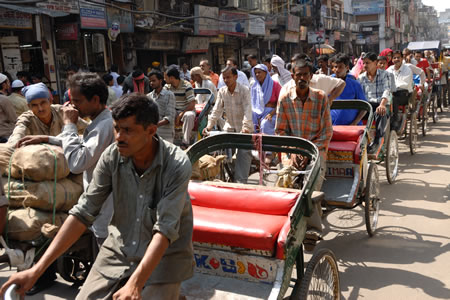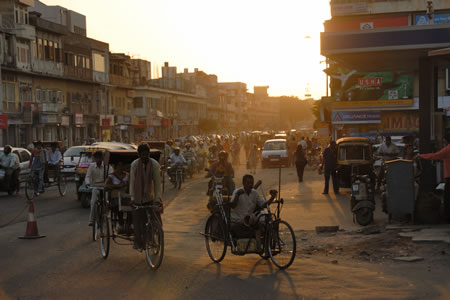English | Dutch |
|
| Escape from the tourist trail | |
:Leh (India) to Alwar (India), Sep-23-07 / Oct-08-07 |
|
After the trekking of twelve days, we took three days of rest in Leh. It was not really resting because we used the days mainly to work on the pictures and the website. Besides that, we mentally prepared ourselves on our visit to Delhi. As you probably know, Delhi is considered as an unpleasant city for its visitors. On one hand because of the confrontation with the poverty and dirtiness, and on the other hand because of the so-called touts. Touts are people (mainly young men) that have the goal to earn quick money from foreigners, mostly in the form of commissions that they get from hotels, shops and travel agencies (which call themselves tourist information). The goal is to convince you to go with them to one of the hotels, shops or travel agencies of their choice, in the hope that you buy something. If you indeed buy something (often after some kind of mental pressure), you pay an amount that is way too high. A part of the profit eventually ends in the pocket of the tout.
On September 24th we finally flew to Delhi after spending a month in Ladakh. We decided to fly in stead of taking the bus, for security reasons. Because of the first snow on the high passes, the bus ride from Leh to Manali can be pretty dangerous. Besides that, the ride of eighteen hours is done by only one bus driver (without proper resting times). We stayed one week in Delhi and considered our stay as tiresome. The number of touts was less than expected, maybe also because we developed some kind of natural “defence system” after a couple of days. But on the other hand, the touts and the fact that most people (shop owners, rickshaw drivers) want to rip you off, had a bigger effect on our mood than expected. It is really tiring to be on the alert of rip offs the whole day. It looks like a local sport to rip off foreigners. The side effect is that you take a defensive and detached attitude while walking through the city. At the moment somebody talks to you in the street, you assume that it is a tout. And indeed, in nine of the ten cases it is a tout. Besides that, you have to be alert in the shops that they do not charge you prices that are more than double than the normal price. More about our stay in Delhi can be found in the article: “Surviving Delhi”. |
|
 |
|
Traffic queue of cycle-rickshaws in Old Delhi |
|
| After a week in Delhi we travelled by local bus to Jaipur, our first destination in Rajasthan. Jaipur is a beautiful city with some great sights like the city palace, the palace of the winds (Hawa Mahal) and some nice forts just outside the city. Jaipur is also called the pink city because of the pink colour of the building in the old part of town. Unfortunately, Jaipur is also heavily located on the tourist trail, meaning that huge numbers of touts are present in the city. It starts already when you arrive by bus. Before the bus really stops on the bus station, the first touts jump into the bus and welcome you with a big smile on their face: “welcome in Jaipur”. In general, touts are easy recognisable. The mainly slickly young men wear ‘modern’ jeans, t-shirts that are too tight and they often wear an earring. The goal of the tout in Jaipur is equal to the touts in Delhi; earn as much and quickly as possible from the foreigners. The best thing you can do is to ignore them completely. Most of them go away after a couple of minutes, but of course, there are also more steadfast touts. We get rid of these guys by threaten them to make a picture and give it to the tourist police. After four days of Jaipur we decided to leave the tourist trail for a while. We have a better time in places where there are not many tourists and the accompanying hassle of touts.
We decided to go to the small town of Alwar, just four hours by bus from Jaipur. Alwar is considered as the oldest kingdom of all former Rajasthani kingdoms. In Alwar you still can find the real atmosphere of Rajasthan and it has a beautiful palace and a great fort that is located on a hill 300 metres above the town. We haven’t seen any other foreigners during our three day stay in Alwar. The people are very friendly and there is no hassle. The highlight of our visit to Alwar was the visit to the Sariska sanctuary, formerly known as the Sariska Tiger Reserve before the tigers were poached (last tiger disappeared in 2004). But despite the fact that the tiger are not in the park anymore, it is still a great park to visit. You can see plenty of other wildlife like leopards, sambars, antelopes, jackals, wild boars and beautiful birds. We hired a jeep and driver for one day and explored the park. During this day we also visited the Kankwari jungle fort, deep in the jungle. When you approach the fort it looms from the jungle. You are probably alone at the fort making it possible to explore the non restored fort all by yourself, giving you the feeling to be a real explorer. This is much more fun than visiting the restored and heavily visited fort of Amber (near Jaipur). | |
 |
|
Sunset at the centre of Jaipur |
|
Close to the Sariska sanctuary is also the haunted city of Bhangarh. This city that was established in 1631 is massively deserted around 1700 because it was cursed. The story goes that a local magician who loved the queen saw his love unrequited and cursed the city. The city is still in amazing good condition giving you the possibility to see how a city was built during that time. You can find good examples of mansions, the market place, the city palace and a couple of beautiful temples. Also at Bagharh we were the only foreigners! A photo impression about Sariska and Alwar can be found here: Sariska & Alwar. We are glad that we made the decision to leave the tourist trail for a while. We even consider skipping some of the typical ‘highlights’ of Rajasthan to avoid the hassle that comes with it. Rajasthan is a very touristy part of India with all the negative consequences. It will be our goal to visit (also) the less visited parts of Rajasthan the next couple of months. Next destination is the Keoladeo Ghana National Park, one of the most important breeding sites in the world for migration birds.
|
|
| <Previous weblog> | |